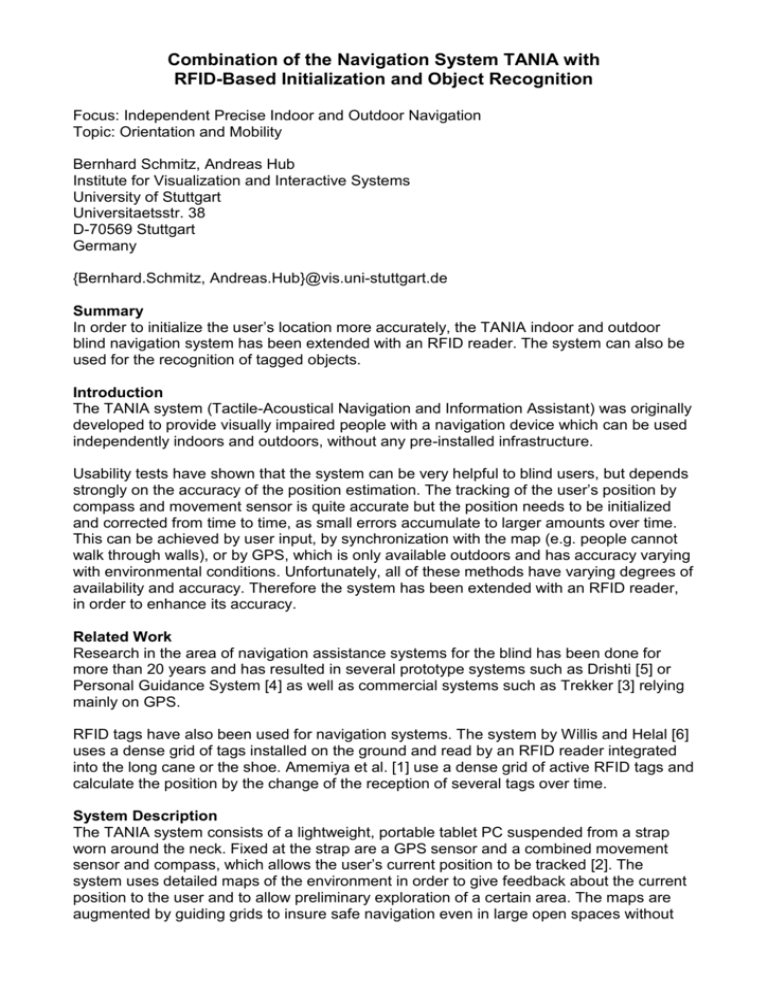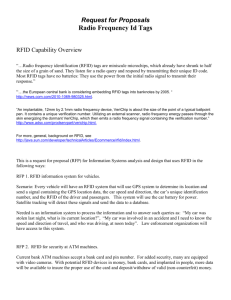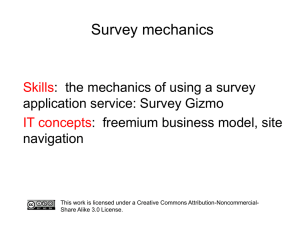Combination of the Navigation System TANIA with - ICEVI
advertisement

Combination of the Navigation System TANIA with
RFID-Based Initialization and Object Recognition
Focus: Independent Precise Indoor and Outdoor Navigation
Topic: Orientation and Mobility
Bernhard Schmitz, Andreas Hub
Institute for Visualization and Interactive Systems
University of Stuttgart
Universitaetsstr. 38
D-70569 Stuttgart
Germany
{Bernhard.Schmitz, Andreas.Hub}@vis.uni-stuttgart.de
Summary
In order to initialize the user’s location more accurately, the TANIA indoor and outdoor
blind navigation system has been extended with an RFID reader. The system can also be
used for the recognition of tagged objects.
Introduction
The TANIA system (Tactile-Acoustical Navigation and Information Assistant) was originally
developed to provide visually impaired people with a navigation device which can be used
independently indoors and outdoors, without any pre-installed infrastructure.
Usability tests have shown that the system can be very helpful to blind users, but depends
strongly on the accuracy of the position estimation. The tracking of the user’s position by
compass and movement sensor is quite accurate but the position needs to be initialized
and corrected from time to time, as small errors accumulate to larger amounts over time.
This can be achieved by user input, by synchronization with the map (e.g. people cannot
walk through walls), or by GPS, which is only available outdoors and has accuracy varying
with environmental conditions. Unfortunately, all of these methods have varying degrees of
availability and accuracy. Therefore the system has been extended with an RFID reader,
in order to enhance its accuracy.
Related Work
Research in the area of navigation assistance systems for the blind has been done for
more than 20 years and has resulted in several prototype systems such as Drishti [5] or
Personal Guidance System [4] as well as commercial systems such as Trekker [3] relying
mainly on GPS.
RFID tags have also been used for navigation systems. The system by Willis and Helal [6]
uses a dense grid of tags installed on the ground and read by an RFID reader integrated
into the long cane or the shoe. Amemiya et al. [1] use a dense grid of active RFID tags and
calculate the position by the change of the reception of several tags over time.
System Description
The TANIA system consists of a lightweight, portable tablet PC suspended from a strap
worn around the neck. Fixed at the strap are a GPS sensor and a combined movement
sensor and compass, which allows the user’s current position to be tracked [2]. The
system uses detailed maps of the environment in order to give feedback about the current
position to the user and to allow preliminary exploration of a certain area. The maps are
augmented by guiding grids to insure safe navigation even in large open spaces without
physical cues, and by text information specific to each environment. Navigation and
environmental information is presented acoustically or in Braille.
As the combination of compass and movement sensor can only track the user’s position
relative to a previous position, the absolute position needs to be initialized at the beginning
and corrected from time to time. This can still be done by the GPS signal or by user input
e.g. when GPS signals are weak or absent. However, the extended version of TANIA
includes an RFID reader, which can detect tags. Fixed at important landmarks, such as
doors or stairways, each tag contains an identification number. Those numbers can be
linked to positional information stored within the map, thereby allowing accurately
detecting the user’s position. Tags can also be linked to corresponding text information
stored within the TANIA system’s map, e.g. the bus schedule at the bus stop.
The combination of RFID positioning with the previous operation mode of TANIA has the
advantage that the system still works without any previously installed infrastructure (i.e.
RFID tags), but that accuracy can now be enhanced by the system’s operator; more tags
resulting in greater accuracy.
Conclusion
First experiments have shown that this enhancement to TANIA represents another step
toward our goal of independent navigation for blind and deafblind people. However,
realization of this goal requires extensive mapping and tagging and is therefore dependent
on public awareness and commitment.
Acknowledgments
This project is funded by the Deutsche Forschungsgemeinschaft within the Collaborative
Research Center 627 “Spatial World Models for Mobile Context-Aware Applications”.
References
[1] Amemiya, T.; Yamashita, J.; Hirota, K. & Hirose, M. (2004), Virtual leading blocks for
the deaf-blind: a real-time way-finder by verbal-nonverbal hybrid interface and highdensity RFID tag space, in Virtual Reality, 2004. Proceedings. IEEE.
[2] Hub, A.; Kombrink, S.; Bosse, K. & Ertl, T. (2007), TANIA – A Tactile-Acoustical
Navigation and Information Assistant for the 2007 CSUN Conference, in Proceedings
of the California State University, Northridge Center on Disabilities' 22nd Annual
International Technology and Persons with Disabilities Conference (CSUN 2007).
[3] Humanware Trekker. www.humanware.com.
[4] Loomis, J. M.; Marston, J. R.; Golledge, G. R. & Klatzky, R. L. (2005), Personal
guidance system for people with visual impairment: A comparison of spatial displays for
route guidance, in Journal of Visual Impairment & Blindness, 99(4).
[5] Ran, L.; Helal, S. & Moore, S. (2004), Drishti: An Integrated Indoor/Outdoor Blind
Navigation System and Service, in PERCOM '04: Proceedings of the Second IEEE
International Conference on Pervasive Computing and Communications (PerCom'04).
[6] Willis, S. & Helal, S. (2005), RFID Information Grid for Blind Navigation and
Wayfinding, in ISWC '05: Proceedings of the Ninth IEEE International Symposium on
Wearable Computers.








